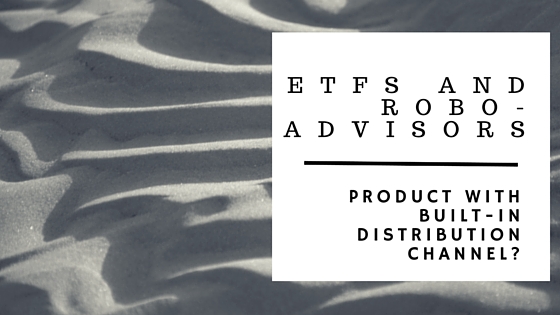The evolution of the social trader
Roboadvisors and ETFs: Product with built-in distribution channel?
Respondents to EY’s latest yearly survey (pdf link) of the global exchange-traded funds (ETFs) and products sector think highly of the tie-in with automated investment advice platforms (roboadvisors).
On the distribution side, managers and promoters of ETFs recognize the need to invest in a dedicated salesforce to drive sales of the investment product. But there’s been a demonstrative surge in interest around digital distribution channels.
According to the report’s authors:
Even so, there is a particularly strong sense that the digital dawn could be a “Eureka” moment for the retail take-up of ETFs. After all, the product and the technology share some common themes: low costs, transparency and breadth of choice. Of those surveyed, 90% view digital channels as an area of opportunity, and 89% expect robo-advisors to accelerate the growth of the industry.
Respondents see a powerful tie-in with traits jointly shared between roboadvisors and ETFs. It’s this overlap that’s concerning to some some experts in the industry who don’t see robos as a new manifestation at all. Rather, according to this viewpoint, it’s just an old financial product (ETFs) with a new distribution channel (roboadvisors).
According to Investment Advisor Magazine‘s Editor-at-Large, Bob Clark:
This suspicion was confirmed in a conversation I had the other day with Babara Roper, the Consumer Federation of America’s director of investor protection. In response to the criticisms of robos that I wrote about in the above mentioned blog (conflicting sources of revenues, self-dealing, and low standards of client care) she said: “Well, how’s that any different from the rest of the financial services industry?”
With the notable exception of independent RIAs, it isn’t any different. And that’s my point about robo “advisors.” They don’t represent a “new” entry into the financial services industry. They are merely a digital delivery system for the old financial services industry, rife with all of its conflicts and client abuses.
Owning the digital distribution channel is already top of mind at firms like BlackRock, the financial firm which owns the massive ETF provider, iShares. In August 2015, BlackRock announced it was purchasing FutureAdvisor, an aspiring roboadvisor that hadn’t quite reached the AUM of larger competitors, Wealthfront and Betterment.
While BlackRock has made it clear it has no plans to market to individual investors via its new roboadvisory offering, it certainly is planning to move its own iShares products through FutureAdvisor.
Instead the firm hopes to use FutureAdvisor to enable banks, brokerage firms, insurers and 401(k) plans to use the company’s digital platform to serve mass affluent investors and millennials, Frank Porcelli, head of BlackRock’s U.S. wealth advisory unit, said in an interview.
By pivoting FutureAdvisor into a B2B play to other financial institutions that market to the end investor, BlackRock will provide a built-in distribution channel to distribute iShares directly to clients of the wealth managers it services.
Schwab has had some very public early success with its Schwab Intelligent Portfolios (SIP) offering. Schwab just reported that its own competitive product to roboadvisors had grown AUM +37% quarter over quarter. SIP now boasts over $5B in AUM in just 2 quarters of operation. That means shortly Schwab’s AUM will approximate all the assets under management in the entire roboadvisor industry. Some of the criticism of Schwab’s Intelligent Portfolios has centered around the bias that the online broker has towards using its own ETFs.
Regardless of who emerges as the largest competitor in the digital advice space, ETFs are the ultimate winner.
[x_share title=”Share this Post” facebook=”true” twitter=”true” linkedin=”true”]
[x_author title=”About the Author”]
Beginner’s Guide to Motif Investing
The investing landscape has changed tremendously over the past few years — mostly in ways that directly benefit individual investors.
- Transparency is increasing
- Fees are decreasing
- Brokers are being phased out in favor of Registered Investment Advisors
- Assets are moving from expensive, actively managed mutual funds to low cost, passively managed exchange traded funds (ETFs)
It’s this last piece that is going to serve as the focal point for this post. In fact, assets invested in U.S. ETFs just exceeded $1 trillion.
ETFs growing like weeds, investors struggle to keep up
If ETFs have evolutionized (it’s not really a revolution) our investment choices, information and commentary on how to use ETFs haven’t quite kept pace. Investors struggle to understand exactly what an ETF’s strategy is and how it’s managed.
Heck, professionals are drowning in trying to make sense of all the new ETF offerings.
A new platform, called Motif Investing, may be changing all this…
12 most mindblowing acquisitions in recent history
Interesting discussion going on at 12Most regarding the most mindblowing acquisitions in history.
Obviously, the fervor around Facebook’s intention to buy photo app, Instagram for $1B prompted this list but I thought it would be a good time to get your feedback into what you think were the most influential mergers in the financial space.
To get things started, I added the $15 billion BlackRock-Barclays Global (BGI) merger which essentially made BlackRock the largest asset manager on the planet but also gave them the crown jewel in the ETF space, which just keeps growing like a weed.
What do you think are notable mergers in our space?
Vote or add your picks below:
Tradestreaming Cascade: The News You Need To Know (Week Of October 23, 2011)
:::::::::::::::::::::::::::::::::::::::::::::::::::::::::::::::::::::::::::::::::::::::::::::::::::::
Every week, I send out an email (free) to my subscribers summarizing the must-see events of the past week. It’s everything about the intersection of technology, social media and investing.
Sign up in the sidebar, at the end of this post, or by going here.
You’ll get your 1st issue on Sunday. :::::::::::::::::::::::::::::::::::::::::::::::::::::::::::::::::::::::::::::::::::::::::::::::::::::
:::::::::::::::::::::::::::::::::::::::::::::::::::::::::::::::::::::::::::::::::::::::::::::::::::::
Investment Products
Online banking keeps customers on hook for fees (NYT)
October 16, 2011
Big banks are struggling and their taking it out on their customers. How long will the currently banked continue to put up with this? BankSimple +1.
Social Media, Technology and Investing
The optimal software free trial strategy (SSRN)
Posted October 4, 2011
Lots of new investment startups and newsletters employ a free trial strategy to increase paid conversions. Do you go full features for X days or limited features forever? Here’s the optimal strategy.
The fear index based on social media sentiment looks bullish (MarketPsych)
Research firm MarketPsych has been profiled on Tradestreaming (go here). Looking at a variety of investor sentiment from thousands of sources, MarketPsych thinks the current market looks bullish.
New app is awesome showcase of stock market data and visualizations (Xignite)
Posted October 14, 2011
StockTouch is a new iOS app that uses a market heat map-type display of breaking stock market movements. New visualizations like StockTouch promise investors a new way to look at market data/info to aid decision making.
Investment Strategies and Research
Continue reading “Tradestreaming Cascade: The News You Need To Know (Week Of October 23, 2011)”
Tradestreaming Cascade: The News You Need To Know (Week Of October 8, 2011)
:::::::::::::::::::::::::::::::::::::::::::::::::::::::::::::::::::::::::::::::::::::::::::::::::::::
Every week, I send out an email (free) to my subscribers summarizing the must-see events of the past week. It’s everything about the intersection of technology, social media and investing.
Sign up in the sidebar, at the end of this post, or by going here.
You’ll get your 1st issue on Sunday. :::::::::::::::::::::::::::::::::::::::::::::::::::::::::::::::::::::::::::::::::::::::::::::::::::::
:::::::::::::::::::::::::::::::::::::::::::::::::::::::::::::::::::::::::::::::::::::::::::::::::::::
Investment Products
Evaluating Vanguard’s new LifeStrategy Funds (Oblivious Investor)
Posted October 5, 2011
Taking a slightly different tack with their pre-packaged retirement funds, Mike Piper seems to like the lower pricing and inclusion of international in the index firm’s fixed allocation funds.
Social Media, Technology and Investing
How to aggregate news like a pro (SmartBlog on Media)
Posted September 30, 2011
I wish I were Matt Drudge. But I’m not. This article provides concrete advice for those publisher looking to provide value by aggregating content — something Tradestreaming friend Meb Faber requested in his call for curated research offerings.
The Power of Facebook and the Launch of Personal Capital (AdvisorGo)
Posted Oct 5, 2011
Weekly AdvisorGo podcast (I’m a co-host) looks into how Facebook changes affect advisors using Facebook and the recent launch of a startup with big plans for online delivery of financial services.
Continue reading “Tradestreaming Cascade: The News You Need To Know (Week Of October 8, 2011)”
ETFs are where it’s at (in terms of new assets)
This is a great chart from the Dorsey Wright guys at alletf.com showing the growth in ETF assets through August 2011.
Takeaways: AUM growth ramping (in spite of a tough August), Blackrock ($BLK) is still a beast, and total number of ETFs at 1301, up 255 from this time last year.

Read ETF Assets Update (alletf.com)
The Emerging Markets Blueprint for Investors
As the U.S. continues its internal struggles over the financial direction of the company, investors are focused overseas more and more.
Why?
That’s where the growth is.
Well, and it’s also getting easier to access emerging markets with new funds, strategies, research, etc.
I wrote a post over at Wealthfront about ways to access emerging markets beyond BRIC.
And it got me thinking — I could use a one page investment resource for emerging markets. So here that is… Continue reading “The Emerging Markets Blueprint for Investors”
Tradestreaming Cascade: Top links from the week ending 4/24/2011
A new addition to Tradestreaming, the Tradestreaming Cascade is a highlight reel of some of the past week’s most interesting information. Much of this comes from my Twitter feed, @newrulesinvest.
The Wizard of Lies: Bernie Madoff and the Death of Trust just came out. Looking forward to reading it.
Comparison of 4 commission free ETF portfolios for less than 20 bps (World Beta)
Introducing the most powerful (premium) stock charts (Ycharts)
PIMCO files for ETF version of Bill Gross’ Total Return Fund (SEC)
Ameriprise gets into the ETF game by buying Grail (ETFdb)
Geezeo launches referral engine to help financial institutions cross-sell (Finextra)
Who is the top stock picker of the decade? (InvestmentNews)
Up-beat note for company-sponsored equity research (Integrity Research)













